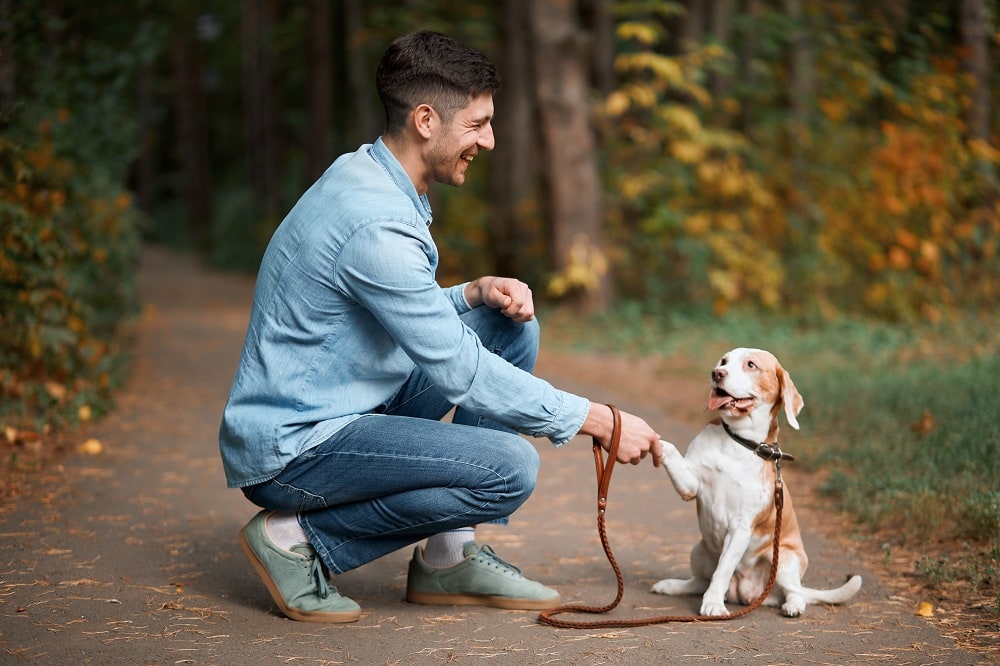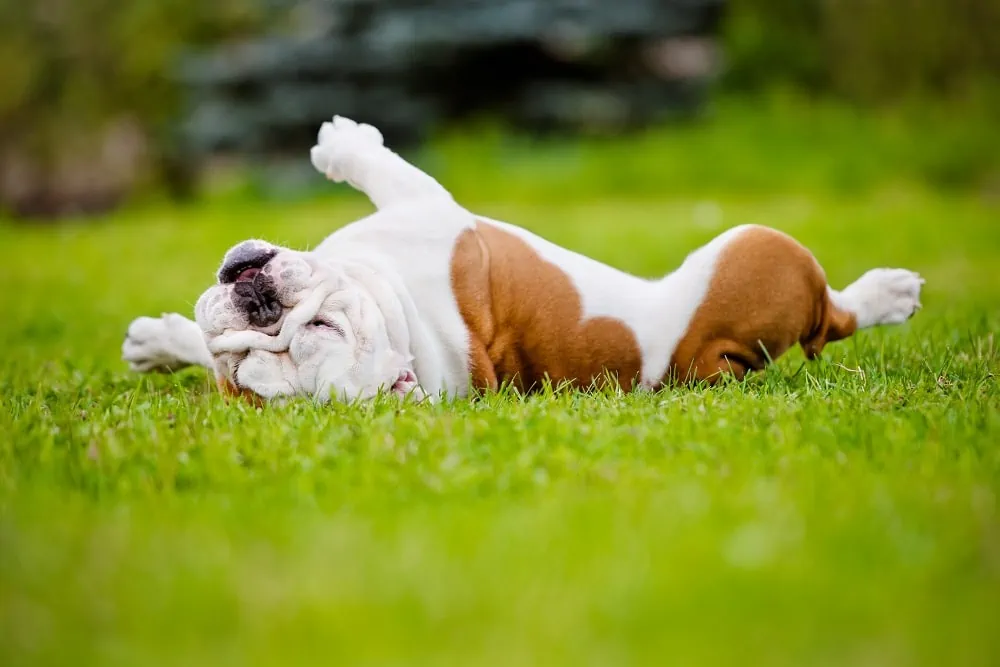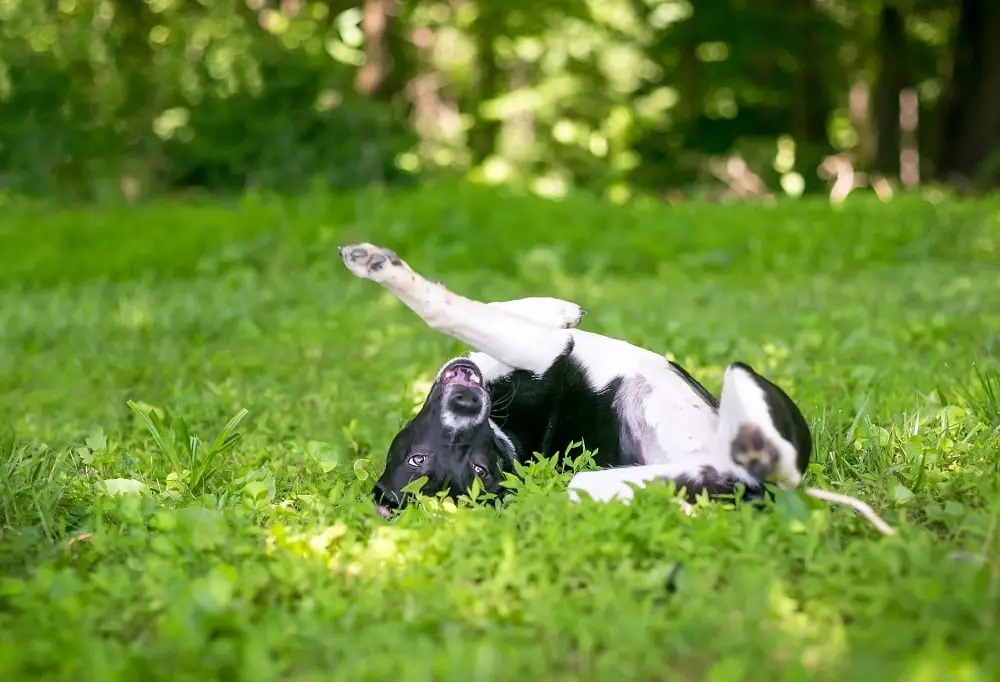We’ve all heard the common saying, “you can’t teach an old dog new tricks.” Usually pertaining to people who are too stubborn in their ways to try something new, the all too familiar phrase carries some truth – but that doesn’t mean it’s always an adage to follow.
Dogs, just like people, need both mental and physical stimulation whether a puppy or full-grown. And, teaching your dog how to roll over is one of the oldest and best tricks in the book.
How do you teach a dog to roll over? To teach a dog how to roll over follow a step by step process that includes reward-based learning and strengthens your bond with your canine. You’ll need patience, a lot of treats, repetition and practice, and a good dose of praise for all of his hard work – and yours!
So, whether he is five years or five months old, following a few simple steps will have him showing off his new moves to your friends in no time.
Dog Training Basics and Benefits

Dogs have an obedient nature. They are inherently able to learn and respond to commands, which could be in large part due to the number of neurons in their brains – a number somewhere around 530 million (source).
Those neurons are responsible for processing and sending information through the central nervous system, and they are also what allows your dog to not only interpret your words but follow through with the actions you intend.
And, perhaps more interestingly, your dog can learn commands in multiple languages, including Dutch! You can read more about this unique characteristic and language differences in training in Dutch Dog Commands.
For better context, a human brain contains about 16 billion neurons, quite a lot more than your dog, but similarly responsible for the comparative level of intelligence among mammals.
So, it’s not the size of the brain that measures his intellect or makes us smarter than your neighbor’s chihuahua, but rather those tiny little neurons that live in the brain’s cortex and teach your pet to problem solve, and to get what he wants – namely the treat dangling above his nose.
Benefits of Training
There are some obvious benefits to training – including basic obedience skills such as sit, stay, and come. They all make your dog much better behaved in social situations, and they’re also commands that are enjoyable for your dog to learn.
Dogs, like many mammals, are incredibly intelligent and learning new skills provides necessary mental stimulation, keeping your dog from getting bored, and thus keeping him from getting into places and situations you’d rather him not be – like in your closet chewing your shoes.
But apart from obedience and other behavioral issues, training your dog is a two-way street, requiring participation from both of you. In this way, training is one of the best ways to further develop your relationship and allow you to do more together – including hiking, camping, and even letting your dog run free while playing frisbee in the park.
Other benefits include being able to control your dog to the degree that you can ensure he isn’t getting himself into dangerous situations, being able to take him more places in public, and creating a mutual relationship of love, trust, and respect.
Basics of Reward-Based Training
Most experts and veterinarians agree that all training should be reward-based. This essentially means giving your dog something he likes in exchange for the desired behavior.
Once he realizes that performing a particular behavior results in something he enjoys, he’ll be much more likely to repeat the behavior in the future.
In order for any training technique to be effective, you’ll need to practice and follow a few basic guidelines, and make sure that you are in a good mood when doing so – if you are frustrated or tired after a long day, your dog will sense that and it’ll make your training session a lot less enjoyable, and a lot less successful.
Choosing the reward
Part of reward-based training is making sure that whatever you are rewarding your dog with during training is something he really likes, and it doesn’t necessarily have to be a treat, though that’ll certainly do the trick most of the time.
Rewards can include praise, a toy, a game that he likes, or anything else that he loves. If he’s not exactly excited about a particular dog biscuit, using it as a reward is not likely going to result in the behavior you are hoping to see.
The best thing you can do is find a reward that is most appealing from your dog’s perspective. If he loves a particular toy, use that as a reward during your training sessions, perhaps in conjunction with a treat.
The idea is that you reserve your dog’s most favorite rewards for the most difficult tasks you are working on (source).
Timing of reinforcement
When beginning to train your dog to accomplish a new task or skill, you’ll likely want to do so in a quiet environment away from distraction (source).
If you begin training outside in your backyard, your dog is much more likely to be distracted by all of the other “rewards” in his surroundings, including smells, other dogs or animals, and the squirrel he is aching to chase.
Once your dog is beginning to master a skill, you can continue training in an environment that has more distraction, but you’ll need to increase the rate of reinforcement.
In other words, until your dog is able to ignore other sounds and smells and focus on your voice and command, you’ll need to continue reinforcement more frequently and with each subsequent step, and quickly enough to avoid losing his attention.
Because your rewards are going to be in competition with other things in his environment, frequent reinforcement with treats or toys that are highly desirable for him are both a must.
We’ll get into the specifics of how and when to reward your dog when you are teaching him to roll over a bit more below.
How Long Will It Take for your Dog to Learn His New Trick
The simplest answer is that it will depend on your dog, his personality, and whether or not your dog already has a grasp of some basic commands, such as sit and stay.
If your dog is not yet able to sit, lie down, or stay on command, you may want to approach those skills first, before you try to teach him more complicated tasks such as rolling over.
Part of your training, as we mentioned earlier, is going to require a lot of repetition and multiple training sessions that are short, about ten minutes each one or two times per day. You don’t want to overwhelm your dog, so short, regular sessions are key.
And, much of the answer as to how long it takes depends less on your dog, and more your ability to stay consistent and committed to the process. Without consistent, day to day reinforcement, training any new skill is going to take a lot longer.
Teaching your Dog to Roll Over: A Step by Step Approach

Teaching your dog to roll over, and even roll over and “play dead” is actually a lot easier than you might think. As we mentioned earlier, it is a lot easier to teach your dog a new trick if he already has some basic commands in his repertoire.
If your dog doesn’t yet know the “down” command, you will want to teach him that first, before attempting to teach him how to roll over since the latter is dependent on him knowing how to lie down on command.
Teaching Your Dog the “Down” Command
You’ll want to have a treat in hand, and you’ll want your dog to know it is there – bring it close to his nose, and then step back.
Then, follow these steps to teach your dog to go from sitting to lying down:
- Once your dog is sitting, kneel down so that you are closer to his level.
- Say the cue word, “down.”
- As you say “down,” move the treat to the floor, right in between his front legs.
- Once your dog’s nose and front elbows are on the floor, give him his reward.
After a few repetitions, lower your empty hand – rather than holding a treat – to the floor. Then, give him his reward only after he is lying down. Likely, he’ll spring back up a few times, and that is okay. Each time, reward the behavior you want to see – him lying down – and then praise him enthusiastically.
You can also start teaching your dog the “down” command by essentially catching him lying down, and reward him for doing so. The idea is to combine the cue word with the action, regardless of whether you “catch” him doing the behavior or if you are luring him with a treat.
Never, ever force your dog into a sitting or lying down position (source). Doing so is not going to help to accomplish the training goal, but rather cause anxiety or fear and confusion for your dog. Always, be sure to keep these training methods short and positive!
Once your dog has mastered down on command, you’re ready to add the next step, rolling over.
Teaching your Dog to Roll Over
The first step in teaching your dog to roll over is to get him into the down position. If you are still working on this command, do so with a reward. Once your dog is in the down position, follow each of the basic steps below:
- Kneel beside your dog with a treat in your hand
- Hold the treat to the side of his head, near his nose
- Move your hand (holding the treat) from his nose toward his shoulder
- Lure him to roll to his side (his eyes will be following the treat)
- Once he is flat on his side with his head on the floor, offer the reward and praise
These initial five steps are part of the process. You’ll want to teach this skill in phases – first down, then showing him that you want him to roll to his side by luring him with a treat.
Do this a few times, and you may even want to focus solely on this beginning phase during the first few training sessions over the course of a day or two.
Once you feel you are ready to move to the next phase, go through each of the above steps. Once your dog is lying flat on his side with his head on the floor, continue as follows:
- Continue moving your hand, holding a second treat, from his shoulder to his back, luring him to follow you
- Keep moving your hand so that he rolls onto his other side
- Once he is following the treat and moving from his side to his back, and onto his other side, add in your cue, “rollover.”
- Finally, reward his effort!
Once your little guy is consistently repeating the above steps, you want to reduce the hand motion and the treat you use in the initial phases of training and depend more heavily on the cue, “roll over,” rewarding him for performing the action on his own (source).
Again, repetition is key. Small, short, positive training sessions and phases are also key. Always end on a positive note, rewarding his behavior each step of the way.
Also remember that all dogs, like people, learn at different paces. Depending on the breed of your dog, his temperament, other skills he has already mastered, and even his age will cause variation in the timing required for him to learn a new skill.
Rolling Over and Playing Dead
So, you’ve gotten your dog to roll over, and now you want to teach him to play dead, too. This is a great trick to show your dog, and sneakily, you can also use it to get him to relax when you know he is ready for a rest.
Once you’ve gotten your dog to lie down and roll over, teaching him to play dead is pretty simple. Teaching this trick is more about the use of your cue words, “play dead” since much of the movement involved is already part of his learned behavior.
If you have followed all of the steps above, you’ll see that part of the process of rolling over requires your dog to lie on his side. All you need to do to add to this is use the cue words “play dead” when he is on his side, giving him a treat each time he stays in position.
The key here, however, is waiting to reward your dog’s behavior until he holds the position for a few moments, increasing the amount of time between his behavior and your reward.
You’ll also want to add in a “release” word so that your dog knows it is okay to get up. The culmination of “playing dead” is to provide the reward only after he has stayed in position and then gotten up at the cue of a release word (source).
You can teach your dog to play dead from his side, or his back – whichever you prefer. Some dogs love a good belly rub, so this is also a great reward option for his successful completion of the task – and avoids the use of too many treats!
For quick and easy steps, check out this video here:
My Dog is Not a Puppy – Can I Still Teach Him to Roll Over and Play Dead?

Yes! Remember, you actually can teach an old dog new tricks, and it’s good for him, too! As with most common phrases and adages, they are not all meant to be followed. No matter your dog’s age, you can certainly teach and train him – and not only will it help him to stay young at heart, but you’ll also strengthen your bond together.
Most of us tend to do less with our pets as they age – less walking, less playing. Sure, part of that is because your little guy doesn’t have the energy he may have had a few years ago (nor do you!).
But, training your dog to accomplish new tricks and tasks is a great way to boost his mental stimulation, and give him much needed exercise, too.
Just keep in mind that as your dog ages, it may take him a bit longer to master new skills. But, keep at it with positive reinforcement and some healthy treats, and your dog can absolutely master rolling over and other easy tricks, such as shaking and even dancing (source).
Final Thoughts
Part of being a dog owner is the fun of teaching and training, and there are so many tricks you can learn and teach your dog. You’ll get the benefits of a closer relationship, good exercise, and quite a lot of fun while you are at it.
Be patient, be positive, and let your dog lead the way – he just might love his new tricks even more than you do!


0 Comments